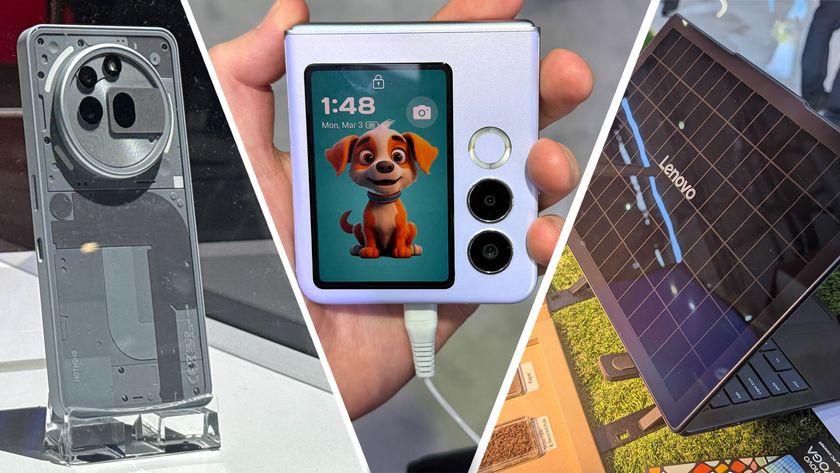Hottest of CES 2022: our 20 favorite launches from the show
These are the winners of TechRadar's Hottest of CES 2022 awards

While CES 2022 wasn't quite the full-blown, in-person event organizers were hoping for, the massive electronics show in Las Vegas, Nevada, still managed to deliver a stellar line-up of exciting technology.
There's so much happening at CES, but there are always some announcements that really grab our attention and for those products, a highly coveted Hottest of CES 2022 TechRadar award is in sight.
The TechRadar team spent all week voting on and debating over our favorite CES 2022 launches. What you'll find below are the results: The 20 hottest products from this year's show.
Congratulations to all our award winners.
LG C2 42-inch OLED TV

LG came out swinging at CES 2022 by announcing a number of 8K and 4K OLEDs, several new QNED mini-LED TVs, and even a MicroLED TV. Most of those screens will forever remain outside our budget… the one exception being the LG 42-inch 4K OLED.
LG is releasing its C-Series OLED in an even smaller, more affordable size. And while we feared that the reduction in size might mean a reduction in specs, for the most part, that hasn't been the case.
The smallest C2 OLED will still have the Alpha a9 Gen. 5 processor like its pricier siblings and support 4K/120Hz via HDMI 2.1 ports.
Get daily insight, inspiration and deals in your inbox
Sign up for breaking news, reviews, opinion, top tech deals, and more.
The only downside is the smallest C2 is stuck with last year's panel. That's not a total bummer though, considering the price could start at under a grand.
Sony Master Series A95K QD-OLED TV

Sony unveiled one of the only truly next-generation TVs at CES in the form of the A95K QD-OLED TV. It's the first QD-OLED unveiled by a major manufacturer, and according to the specs, it will deliver everything we want from the latest and greatest panel technology.
QD-OLED combines the self-emissive organic light-emitting diodes that give OLED its perfect black levels with the color saturation of quantum dots. The result is a screen that has 200% of the color saturation of a traditional LED-LCD screen, with higher peak brightness and wider viewing angles than an OLED.
We'll still need to test it in our own homes before we can shower it with accolades, but based on everything we know about the A95K, it's the evolution of OLED we've been waiting for.
Noveto N1 Invisible Headphones
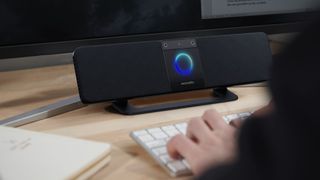
Looking a little like a mini soundbar, the Noveto N1 is a rather novel audio device that uses beamforming technology to create a binaural audio experience without the need for a pair of headphones – but unlike a soundbar, this audio can only be heard by the user's own ears.
It works by transmitting ultrasound silently through the air, which converges into audible pockets just outside of your ears - creating an experience similar to wearing a pair of headphones.
According to Noveto, anyone else in the room will only be able to hear "a whisper of sound," while the user is immersed in three-dimensional spatial audio. In other words, Noveto recorded up to 90% (20dB) audio reduction when 1 meter away from the listener.
Should you move or turn your head, motion sensors allow for facial recognition, helping the N1 to track your ears and ensure the sound hits the right spot.
Exeger / Mahyt self-charging speaker
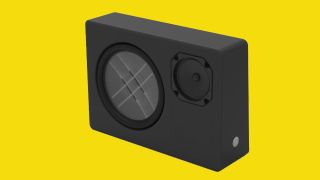
This is a new prototype portable speaker created by tech companies Exeger and Mayht.
Kitted out with Exeger's Powerfoyle material that can convert any light source into energy (as seen on the Urbanista Los Angeles headphones), the Bluetooth speaker is essentially self-charging, able to top up its reserves whether you're indoors or out.
The speaker also contains a new kind of dual-membrane driver developed by Mayht, which it claims can match the power of a speaker ten times the size. Mayht's drivers are flatter and more compact than most on the market, but the company claims they're no less powerful or sonically adept.
While it's not available to the public just yet, it gives us an interesting insight into where the world of audio might be heading in the next few years.
Samsung SolarCell Remote (2022)
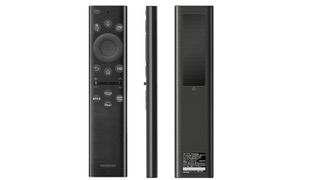
Samsung's SolarCell Remote may be the first-ever to wirelessly charge via your router. The South Korean tech giant took the solar-powered Eco Remote it introduced at last year's CES and gave it a remarkable upgrade: the ability to harvest RF signals from your router to maintain a charge.
The concept of RF Energy harvesting is not new, but this may be the first time the technology has been employed in consumer electronics.
Unlike other wireless charging solutions, such as the near-field Qi, the SolarCell Remote doesn't have to be very near or in contact with the router. RF Energy Harvesting can - unobstructed - reach devices up to 40 meters away.
Since the remote doesn't need a charging base and employs a pair of wireless charging technologies (solar and RF energy harvesting), it can constantly sip energy from your router and, if face down, the solar panel on the back can charge via your end table lamp.
Samsung 'The Freestyle'

Samsung is letting us take its home cinema experience on the go - thanks to the newly announced The Freestyle projector.
As portable projectors go, The Freestyle ticks plenty of boxes. The whole device weighs less than 2lbs (under 1Kg), so it should be easy enough to take with you on the go, and its auto-leveling features and adjustable stand should mean you won't struggle to set up a cinema wherever you are.
On top of that, this all-in-one device comes with a built-in 360-degree sound system - so there'll be no need to carry around additional speakers.
Eufy Security Video Doorbell Dual

Eufy introduced a new video doorbell that has not one but two cameras. This lets you see a detailed view of the face and body of whoever is at your doorstep, as well as any packages they have resting on the ground.
The Eufy Security Video Doorbell Dual (Battery) has a 2K camera with a 160-degree field of view at the top, while the lower-quality Full HD lens, offering a 120-degree field of view, sits on the angled base of the doorbell to capture the ground.
Powered by a rechargeable battery, so there's no need for existing doorbell wiring, it connects wirelessly to the HomeBase 2, which provides 16GB of storage space.
Vivo V23 series

Pitched perfectly at selfie-taking lovers, Vivo has come up with the Vivo V23 and the delightful V23 Pro. It has two front-facing cameras with a 50MP main camera and an 8MP ultra-wide lens for group selfies. The 50MP main selfie camera is the highest-resolution sensor we've seen on a front-facing camera.
It's also possible to record 4K videos on the front camera with a mode that means all videos can be automatically 'beautified', much like how Portrait mode spruces things up with still images.
Elsewhere, the Vivo V23 Pro offers a 108MP main camera and 8MP ultra-wide and 2MP macro lenses. The phone uses a 6.56-inch FHD+ 90Hz display, so it should be an appealing option for anyone keen to stream on the move. Performance-wise, it uses the MediaTek Dimensity 1200 chipset, which offers 5G compatibility.
Vivo also has the Vivo V23, which offers a similar experience to the V23 Pro, but a little lower in spec. It still has two front-facing cameras with a 50MP main camera and an 8MP ultra-wide option, but the rear camera drops down to a still fairly reliable 64MP sensor. It's also a touch smaller with a 6.44-inch screen - plus it uses a slower chipset in the form of the MediaTek Dimensity 920.
- Our hands-on Vivo V23 review
BMW iX Flow concept

It's the sort of thing you'd expect to see in a James Bond film, but BMW has made a color-changing car that actually works in real life.
The customized, fully electric BMW iX has body panels made from E Ink displays - the same technology you find in the screen of a Kindle ereader - in a system it's calling 'iX Flow'.
The modified BMW iX can switch from white to black and back at the press of a button. Sign us up, we're sold.
Mercedes-Benz Vision EQXX concept

The Mercedes Vision EQXX concept (or "road-legal research prototype" as it's referred to in official comms) has some rather impressive specs. It boasts over 1,000km (620 miles) of range from a single charge, while inside there's a huge 47.5-inch display stretching the entire width of the dash.
Mercedes' engineers have worked their magic when it comes to the battery, taking the power pack from the EQS and reducing its physical size by 50% and weight by 30%, while also extending its range.
The Vision EQXX also features 125 solar cells on its roof that can replenish up to 25km of range per day, the best drag coefficient of any car at 0.17 making it supremely aerodynamic. It also uses a wide range of recycled and sustainable materials both inside and out.
While this particular model won't go on sale, Mercedes says it's extremely close to a production-ready vehicle, and many of the features seen here will feature in future EVs from the brand.
Alienware Project Nyx

The Alienware Project Nyx is essentially a gaming server that you can use to play games remotely on any device in your home.
The whole reason for this is that because all of the processing is done on a centralized device in your home, it cuts down on the latency that plagues cloud gaming platforms.
It's an incredibly cool concept, and we were able to see it in action, but because it's so early in development and possibly won't ever come out, it's probably best not to get your hopes up for this thing. Obviously, that doesn't mean we can't geek out about it a little bit.
It's a giant black obelisk with RGB lighting emitting around it - because, of course, it has RGB - and it looks like it weighs a good 60lbs, at least. Alienware obviously wasn't telling us what hardware was in it, but just from getting a look at it, it's nothing to shake a stick at.
Nvidia RTX 3090 Ti
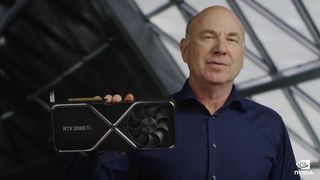
As a super-charged upgrade to Nvidia's flagship RTX 3090, the RTX 3090 Ti is now the most powerful gaming graphics card Nvidia has ever made.
Unless you're aiming to play the very latest games at 8K resolution, then the RTX 3090 Ti will likely be overkill. No games currently properly stress the RTX 3090, and the RTX 3080 Ti and RTX 3080 are plenty capable.
Still, we always love seeing new GPUs, especially ones that really push the envelope, and the RTX 3090 Ti looks set to do just that. It's a" monster GPU" according to Nvidia's Jeff Fisher.
Sadly, we didn't get much information about the RTX 3090 Ti, except that it has 24GB of GDDR6X memory with 21GB/s bandwidth, which is the same amount of memory as the RTX 3090, but much faster bandwidth. Plus it comes with 40 shader teraflops, 78 RT teraflops, and 320 tensor teraflops.
Nvidia RTX 3050

If you've been looking to upgrade from an old GTX card, but have been turned off by the exorbitant costs of Nvidia's recent graphics card releases, the Nvidia RTX 3050 might be your best bet to take advantage of real-time ray tracing, DLSS, and more of what Ampere has to offer.
The RTX 3050 achieves 18 TFLOPS of ray tracing performance, 73 TFLOPS of tensor performance, and 9 TFLOPS of shader performance, according to Nvidia.
The biggest gain you're likely to see is from DLSS. And for $249, the additional frame rate boost is definitely worth it, especially if you're coming from an older GTX 50-series card.
Intel Alder Lake mobile

Intel has revealed its much-anticipated Alder Lake mobile processors which will be in new gaming laptops and Ultrabooks this year.
In fact, the new H-series chips – the most powerful Alder Lake notebook CPUs – will be coming to over 100 laptop designs in the enthusiast and gaming laptop categories, plus ultraportables too.
The H-series range is headed up by the flagship Core i9-12900HK. This processor has six performance cores (with hyper-threading) and eight efficiency cores (without hyper-threading), making a total of 14-cores and 20-threads.
Intel claims the new 12900HK is up to 28% faster in gaming when compared to both the 11980HK and Ryzen 9 5900HX, and 30% quicker for content creation compared to its predecessor.
PSVR 2 and Sense Controllers

Sony had a bit of a surprise for us at CES 2022. The Japanese tech giant officially confirmed its next-gen virtual reality headset is on the way, and it's somewhat predictably called PlayStation VR 2.
The headset, also referred to as PSVR 2, will debut alongside the company's new PlayStation VR2 Sense controller, which is clearly inspired by the likes of the Oculus Touch.
Much like the PS5's excellent DualSense controller, Sony's new VR2 Sense controller will also boast haptic feedback and adaptive triggers.
Sony also announced Horizon Call of the Mountain, a VR spin-off of its extremely popular PlayStation-exclusive Horizon series, which is being developed by Guerrilla Games and Firesprite.
Garmin Vivomove Sport

The Vivomove Sport is a new addition to Garmin's range of hybrid watches, which have an analog dial with a hidden digital display to show your daily fitness stats like step count, stairs climbed, calories burned, and Intensity Minutes.
The watch hands move out of the way when you want to see your activity metrics, then glide back into place when you've finished.
The new Vivomove Sport has Garmin's Body Battery monitoring, which uses your sleep score and activity levels to determine how much energy you have for the day ahead. There's also all-day stress tracking based on heart rate variability, sleep tracking, and a range of dedicated sports tracking modes.
Oral-B iO Series 10

The Oral-B iO Series 10 is a successor to the iO Series 9 and has one big upgrade.
Most electric toothbrushes vibrate every 30 seconds to remind you to move onto a different quadrant, plus a timer display on the handle. However, it can be easy to lose count of the vibrations and looking at the display means either peering awkwardly at the brush in your mouth, or pausing your cleaning partway through.
The Oral-B iO Series 10 solves that problem with a charging base that doubles as a secondary display. Four lights indicate which quadrant you should be cleaning, and digits on the side show how long you've been brushing. The time is displayed on the side of the base when it's not in use.
Sengled Smart Health Monitoring Light

The Sengled Smart Health Monitoring Light is not just a smart bulb that connects to your Alexa or Google Assistant smart network, it's a human vitals detection system.
This LED bulb uses a sophisticated Frequency-Modulated Continuous Wave (FMCW) radar to map your room (or home if you have multiple bulbs) and detect its occupants.
If you've fallen and you can't get up, you're sleeping poorly, or your heart is racing, this lightbulb that can look out for you, let you know what's up, and even call for help.
Amagami Ham Ham

When you're feeling stressed, do you sometimes absentmindedly nibble on your finger? It helps a little, right? Now imagine a robot that can do it for you. That's the simple and slightly strange concept behind Yukai Engineering's new Amagami Ham Ham robot bear. Stick your finger in its tiny mouth and it will nibble on the digit.
The character design is based on Liv Heart's Nemu Nemu series, which, somewhat unsurprisingly, deals with a white bear who creates "Healing Study School" to help humans relax and heal.
Amagami, which in Japanese means "soft biting," doesn't just automatically chomp down on a finger when you place one in its soft fabric mouth. The robot algorithm provides for two dozen different nibbling styles. There's no description of the different modes, but all appear to be "gentle."
Invoxia Smart Dog Collar

Invoxia's Smart Dog Collar looks like it could be a genuine leap forward in monitoring pet health.
Able to track both respiratory and heart rates, it's essentially an Apple Watch for dogs, and will be available to purchase sometime in mid-2022 for $99 (around £75 / AU$140). An additional $12.99 per month subscription (around £10 / AU$18) is required to access the collar's GPS features.
Invoxia has partnered with veterinary cardiologists to develop a deep learning AI for its smart dog collar that makes use of miniaturized radar sensors. These sensors were ideal as they can take readings regardless of how hairy your dog is.
Your doggy shouldn't mind wearing the collar either, as it fits loosely and comfortably around their neck, ditching the tight fit of typical smart tracker devices.

TechRadar's former Global Managing Editor, John has been a technology journalist for more than a decade, and over the years has built up a vast knowledge of the tech industry. He’s interviewed CEOs from some of the world’s biggest tech firms, visited their HQs, and appeared on live TV and radio, including Sky News, BBC News, BBC World News, Al Jazeera, LBC, and BBC Radio 4.
